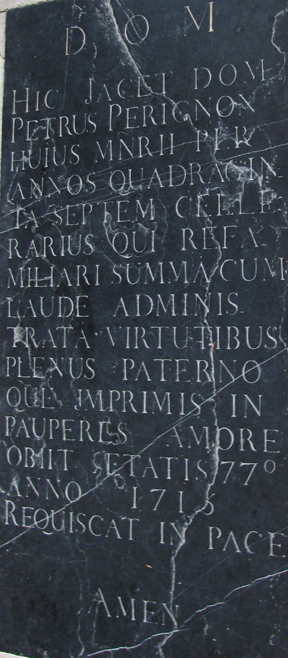
This is the tombstone of Dom Petrus (Pierre) Pérignon in the abbey church of Hautvillers in France’s Champagne-Ardenne region. As cellar master at the Benedictine Abbey of Hautvillers, Dom Pérignon (1639-1715) was instrumental in development of the clear, bubbly, cork-popping Champagne as we know it today. Hautvillers, located 4½ miles from Epernay, overlooks a wide sweep of vineyards along the slopes of the Mountain of Reims in the heart of the Champagne-producing region.

The dom didn’t “invent” Champagne, since mastery of the double-fermented sparkling wine drew also from the expertise and experimentation of other cellar masters at the time, but his name comes to the forefront of developments in all facets of developing the Champagne method of producing quality sparkling wine.
It’s now difficult to dissociate the monk Dom Pérignon from the trademark of the same name that belongs to Moët & Chandon and is used for a high-end Champagne. But we’re talking here of the man, not the brand. Pérignon is entombed beside another monk-cum-trademark Dom Ruinart.
Though vines had been thriving in the Champagne region since Roman times, mastering the natural effervescence of local wines and developing the world’s most evocative sparkling wine began in the second half of the 17th century, thanks in part to curiosity and efforts of Dom Pérignon.
Since the abbey required peasants within their zone to tithe (i.e. to contibute a tenth part of their harvest), Hautvillers had the advantage and the challenge of producing wine from different grape varieties grown in different soils. Dom Pérignon learned to select the best of these and to blend them.
He was also part of a movement:
– to clarify the wine, which required a cleaner and quicker pressing process so that black grapes would produce a white juice (and hence wine) without their skin bleeding into the color of the juice;
– to understand, encourage, and control the double-fermentation that turns still wine into bubbly;
– to develop bottles and particularly stoppers (eventually cork) that would withstand the pressure of sparking wine;
– to promote the qualities and benefits of the sparkling wine of Champagne.
Because of Dom Pérignon’s instrumental role in the development of Champagne, Hautvillers calls itself Le berceau du Champagne, “The Cradle of Champagne.” Click on the link below to see where Hauvillers is on the map.
Agrandir le plan
For more on tasting and understanding Champagne, see A Champagne Diary and The Birthplace of Bubbles, also on France Revisited.
Note: There is an oft-repeated falsehood that Dom Pérignon and Louis XIV were born and died the same day. It isn’t true.

